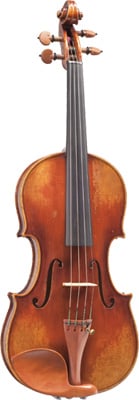Many of us don’t pay very much attention to our bridges unless they fall down, go askew, or break. But do we realize how important the violin bridge is to the setup of the instrument and how much its position can affect our sound? Here are some notes on violin bridges to help keep you informed and sounding your best. The Purpose of Your Bridge
The Purpose of Your Bridge
First of all, the violin bridge suspends the strings above the instrument in their proper playing position. The height and shape of the bridge are thereby very important for the setup of the instrument. Secondly, the violin bridge conveys the vibrations from the strings into the body of the instrument. A string vibrating by itself doesn’t produce very much volume, but “plugged in” to the resonating chamber of the violin through the bridge its sound becomes so powerful that it can potentially be heard over an entire orchestra.
The violin bridge is strategically positioned so that the foot on its G-string side sits directly above the bass bar, which extends nearly down the length of the strings and conveys the vibrations through a greater area of the top of the instrument. The E-string side of the bridge, meanwhile, sits closely above the sound post. The sound post acts both as a pivot for the bridge’s vibrations as well as a means of conveying the vibrations to the back of the instrument.
What About Setup?
The shape and placement of the violin bridge are critical for maximizing the instrument’s potential.
- The bridge feet should be centered on the f-hole notches.
- The crown (top) of the bridge should be the same shape as that of the fingerboard. This produces a consistent string height for all four strings.
- The feet must be completely flush with the face of the instrument. If they aren’t, then not all of the string vibrations are being conveyed into the instrument and the sound quality is definitely suffering.
- The side of the bridge closest to the tailpiece needs to be perpendicular with the face of the instrument.
Do Some Damage Control, But Only Some
The violinist should be able to fix some common bridge problems on their own with reference
to the above setup specifications. However, here are some situations where you will definitely need professional help:
- If the bridge is warped then it will need to be replaced. A warped bridge is not only inhibiting the sound of the instrument, but it is also at risk of breaking.
- If the strings have worn deeply into the crown of the bridge then the
 bridge needs to be replaced. Typically about 75% of the string should be sitting above the bridge rather than inside the notch. If it sits any further into the bridge then it is being muffled.
bridge needs to be replaced. Typically about 75% of the string should be sitting above the bridge rather than inside the notch. If it sits any further into the bridge then it is being muffled. - If the bridge has fallen down completely and the soundpost is rolling around inside the violin, do NOT attempt to fix this yourself. The soundpost needs to be reset by a professional. Without the support of the soundpost, the face of the instrument is not able to withstand the forty pounds of pressure that the strings exert on the violin through the bridge!
It is very important to be continually aware of your bridge placement. Slight changes in humidity, temperature, or even changing your strings can cause the bridge to go askew. Simple observation and maintenance will ensure that your bridge will have a long lifespan and that your instrument will be sounding its best.


